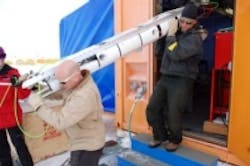Page 2: Vision-guided robot helps make new discoveries under the ice in Antarctica
Editor's note: This article is continued frompage one.
While it is not a video stream, the scientists involved in the project appreciate being able to zoom in on a 5 MPixel image, suggested Zook.
The cameras perform on-board jpeg compression at a rate that enables the team to operate the vehicle smoothly while keeping a total delay of less than 200 ms, and keeping bandwidth usage low. Custom viewing software is utilized in order to adjust settings such as exposure, color compression, and binning to increase frame rate. This, according to Burnett, allows the team to take instantaneous full resolution images with a key stroke.
In addition, this camera has anaccessory board that provides a number of additional features, including on-board CF storage, configurable USB ports (one of which is used to control a focus motor), and a built-in pulse synchronization control for capturing multiple images simultaneously across a network.
In addition to unveiling new information on how Antarctica’s ice sheets are affected by rising temperatures, the project also uncovered a unique ecosystem of fish and invertebrates living in an estuary deep beneath the Antarctic ice off the coastline of West Antarctica. Furthermore, the robot provided a first look at what’s known as the “grounding zone,” where the ice shelf meets the sea floor.
"This season we accessed another critical polar environment , which has never been directly sampled by scientists before: the grounding zone of the Antarctic ice sheet," said Slawek Tulaczyk, a glaciologist from the University of California, Santa Cruz, and a chief scientist on the project.
In a previous project, UNL and ANDRILL team members deployed the SCINI remotely-operated vehicle under the ice, where itdiscovered a new small species of sea anemones living in the underside of the Ross Ice Shelf off Antarctica.
This particular project was the first deployment of Deep SCINI, which was designed for deployment in ice and water depths of greater than 1,000 meters.
"This is the first time that Deep-SCINI ROV has been used in the field and it passed this test with flying colors," Rack said, "collecting video of fish living under the ice shelf in this extremely hostile environment far from the front of the ice shelf."
Preliminary findings from the project may help measure how fast the ice is melting and the stability of the ice shelf, as a weakening or collapse of the Ross Ice Shelf would allow glaciers to flow more rapidly into the ocean, raising global sea level.
View theUNL press release.
Share your vision-related news by contactingJames Carroll, Senior Web Editor, Vision Systems Design
To receive news like this in your inbox,click here.
Join ourLinkedIn group | Like us on Facebook | Follow us on Twitter| Check us out on Google +
Page 1 | Page 2
About the Author

James Carroll
Former VSD Editor James Carroll joined the team 2013. Carroll covered machine vision and imaging from numerous angles, including application stories, industry news, market updates, and new products. In addition to writing and editing articles, Carroll managed the Innovators Awards program and webcasts.

